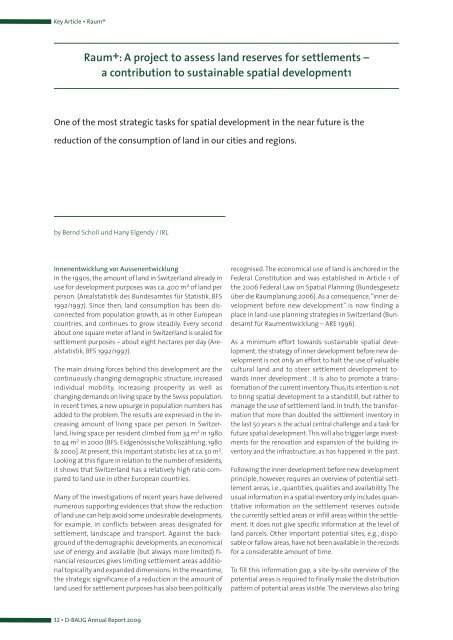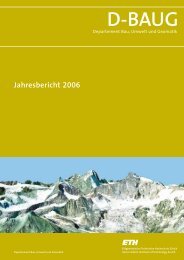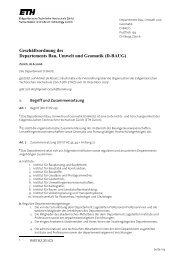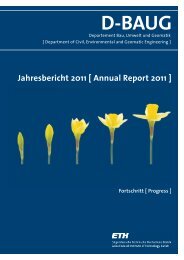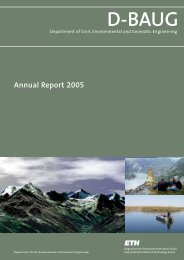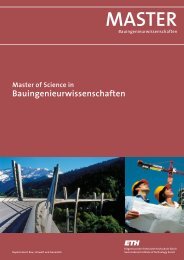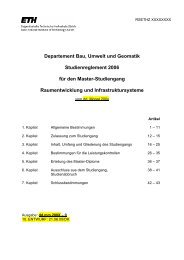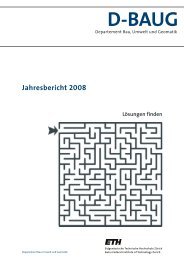D-BAUG - Departement Bau, Umwelt und Geomatik - ETH Zürich
D-BAUG - Departement Bau, Umwelt und Geomatik - ETH Zürich
D-BAUG - Departement Bau, Umwelt und Geomatik - ETH Zürich
Create successful ePaper yourself
Turn your PDF publications into a flip-book with our unique Google optimized e-Paper software.
Key Article ▪ Raum +<br />
Raum+: A project to assess land reserves for settlements –<br />
a contribution to sustainable spatial development1<br />
One of the most strategic tasks for spatial development in the near future is the<br />
reduction of the consumption of land in our cities and regions.<br />
by Bernd Scholl <strong>und</strong> Hany Elgendy / IRL<br />
Innenentwicklung vor Aussenentwicklung<br />
In the 1990s, the amount of land in Switzerland already in<br />
use for development purposes was ca. 400 m 2 of land per<br />
person. (Arealstatistik des B<strong>und</strong>esamtes für Statistik, BFS<br />
1992/1997). Since then, land consumption has been disconnected<br />
from population growth, as in other European<br />
countries, and continues to grow steadily. Every second<br />
about one square meter of land in Switzerland is sealed for<br />
settlement purposes – about eight hectares per day (Arealstatistik,<br />
BFS 1992/1997).<br />
The main driving forces behind this development are the<br />
continuously changing demographic structure, increased<br />
individual mobility, increasing prosperity as well as<br />
changing demands on living space by the Swiss population.<br />
In recent times, a new upsurge in population numbers has<br />
added to the problem. The results are expressed in the increasing<br />
amount of living space per person. In Switzerland,<br />
living space per resident climbed from 34 m 2 in 1980<br />
to 44 m 2 in 2000 (BFS: Eidgenössische Volkszählung, 1980<br />
& 2000]. At present, this important statistic lies at ca. 50 m 2 .<br />
Looking at this figure in relation to the number of residents,<br />
it shows that Switzerland has a relatively high ratio compared<br />
to land use in other European countries.<br />
Many of the investigations of recent years have delivered<br />
numerous supporting evidences that show the reduction<br />
of land use can help avoid some <strong>und</strong>esirable developments,<br />
for example, in conflicts between areas designated for<br />
settlement, landscape and transport. Against the backgro<strong>und</strong><br />
of the demographic developments, an economical<br />
use of energy and available (but always more limited) financial<br />
resources gives limiting settlement areas additional<br />
topicality and expanded dimensions. In the meantime,<br />
the strategic significance of a reduction in the amount of<br />
land used for settlement purposes has also been politically<br />
32 ▪ D-<strong>BAUG</strong> Annual Report 2009<br />
recognised. The economical use of land is anchored in the<br />
Federal Constitution and was established in Article 1 of<br />
the 2006 Federal Law on Spatial Planning (B<strong>und</strong>esgesetz<br />
über die Raumplanung 2006). As a consequence,“inner development<br />
before new development” is now finding a<br />
place in land-use planning strategies in Switzerland (B<strong>und</strong>esamt<br />
für Raumentwicklung – ARE 1996).<br />
As a minimum effort towards sustainable spatial development,<br />
the strategy of inner development before new development<br />
is not only an effort to halt the use of valuable<br />
cultural land and to steer settlement development towards<br />
inner development , it is also to promote a transformation<br />
of the current inventory.Thus, its intention is not<br />
to bring spatial development to a standstill, but rather to<br />
manage the use of settlement land. In truth, the transformation<br />
that more than doubled the settlement inventory in<br />
the last 50 years is the actual central challenge and a task for<br />
future spatial development. This will also trigger large investments<br />
for the renovation and expansion of the building inventory<br />
and the infrastructure, as has happened in the past.<br />
Following the inner development before new development<br />
principle, however, requires an overview of potential settlement<br />
areas, i.e., quantities, qualities and availability. The<br />
usual information in a spatial inventory only includes quantitative<br />
information on the settlement reserves outside<br />
the currently settled areas or infill areas within the settlement.<br />
It does not give specific information at the level of<br />
land parcels. Other important potential sites, e.g., disposable<br />
or fallow areas, have not been available in the records<br />
for a considerable amount of time.<br />
To fill this information gap, a site-by-site overview of the<br />
potential areas is required to finally make the distribution<br />
pattern of potential areas visible.The overviews also bring


